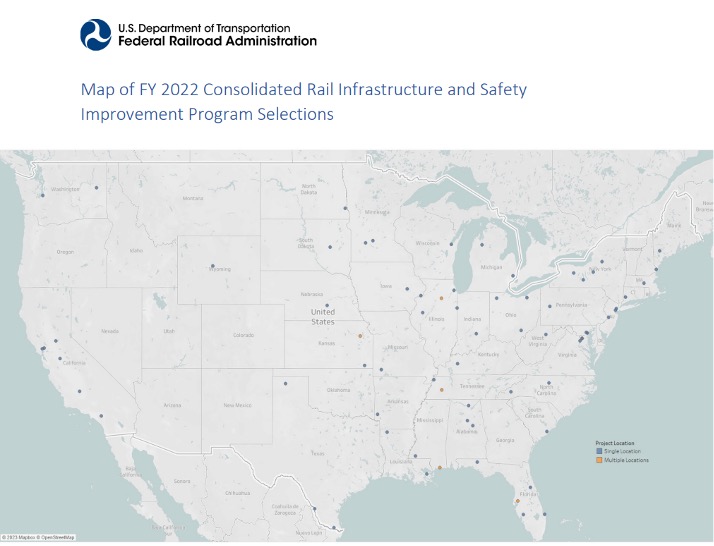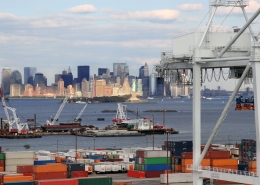On September 25th, the Biden administration announced a new round of rail infrastructure funding. The Federal Railroad Administration (FRA) announced $1.4 billion for 70 projects across 35 states and the District of Columbia, through the Consolidated Rail Infrastructure and Safety Improvements (CRISI) program. While CRISI was created in 2015, this round of funding was the first since the bipartisan infrastructure law expanded the program and significantly increased funding.
Out of the discretionary grant programs that come out of the FRA, the CRISI grants cover a wide range of projects and eligible participants, allocating funding from grade-crossing improvements to regional rail corridor development plans and funding set aside for both passenger and freight rail. The 2022 Notice of Funding Opportunity (NOFO) also includes an expanded list of eligible participants. The past Notice of Funding Opportunities from 2017 to 2020 have had a consistent list of eligible participants, but under the 2022 NOFO, the list now includes the District of Columbia, federally recognized Native American tribes, as well as any association representing one or more Class II or III railroads.
While the projects cover a range of different areas covered by the grant program, there are four consistent themes in the majority of projects: rural investment, rail safety, sustainable transportation, and passenger rail improvements.

Source: Federal Railroad Administration, FY22 CIRISI Selection: Project Summaries, 2023.
Rural Investments
The majority of funding in the FRA award is going towards projects in rural areas. Investments are planned for rehabilitating bridges, upgrading signaling infrastructure, and track improvements along the mainline. The goals of these investments are to upgrade the track standards from Class 1 or 2 to Class 3 or 4, which allow for greater speeds on the track, and improve the track structure capacity to hold standard 286,000-pound railcars. In rural areas, rail infrastructure is less utilized and aging track infrastructure limits the capacity of the tracks and how fast trains can travel to rural destinations or rural industrial customers. The CRISI grants that go to rural areas can provide the necessary funding to keep rural areas connected to the nation’s freight and passenger rail network. In Michigan for example, the Manistee River Bridge replacement project will see improvements to the 135-year-old Manistee River Bridge and support rail service to shippers in the northwest of Michigan’s lower peninsula.
A notable rural investment affecting passenger rail is funding allocated for the Gulf Coast Corridor Improvement Project. Large sections of rail infrastructure were destroyed in the Gulf Coast region by Hurricane Katrina in 2005, consequently suspending passenger rail service between Baton Rouge, Louisiana, and the Florida panhandle. For many years, the Southern Rail Commission has been working to re-establish passenger rail service and link the communities, economies, and nearly 2 million residents of the Gulf Coast together. The project includes track and signal improvements, grade crossing upgrades, and station improvements along the Gulf Coast. The goal is to introduce two round–trip intercity passenger train services. The railroad improvements will also provide an evacuation route, support tourism, and provide transportation access to communities with high poverty rates.
A Big Win for Short Lines
Short line rail is a big winner in this round of FRA funding. These are small Class II and III railroads that employ a small number of people and run over an average of 79 route miles, according to the American Short Line and Regional Railroad Association (ASLRRA). A statement from the organization praised the FRA funding award, noting that 47 of the 70 projects (representing a total of $720 million through the CRISI grant program) are for short lines. Short line railroads offer a first-mile or last-mile connection to manufacturing, energy, and industrial customers. Many short lines operate in rural areas where the track infrastructure may not be updated or sophisticated to handle large amounts of freight traffic. Investments in improving track capacity, bridges, and grade crossings will keep short lines and their customers connected to the transportation network. Accordingly, the CRISI program is the only federal program in which short lines are eligible, making it a vital source of support for short lines. Past CRISI awards included investments in rural areas and smaller railroads, but the newest FRA award represents the largest investment so far and reaches the largest amount of short lines.
Rail Safety
Railroad safety has been a prominent topic of political conversation following the Norfolk Southern derailment in East Palestine, Ohio. Funding for rail safety in the recent FRA award is evident in railroad grade crossing projects and anti-trespassing projects, among others. For example, the City of Greensboro in North Carolina is receiving money to support a proposed program to increase education and enforcement about trespassing. The project aims to create a culture of railroad safety in the community and prevent unnecessary injuries or fatalities caused by trespassing onto the railroad and is an important example of a project focused on awareness and education about rail safety. As important as the physical rail safety infrastructure is, spreading awareness to the public is just as crucial. Funding rail safety educational programs supports state and local safety initiatives.
Sustainable Transportation
Sustainable transportation is another topic of conversation, one that includes electric vehicles and reducing carbon emissions. Part of the CRISI grant funding goes to emissions-reduction projects. Money in the FRA award is going to projects in California, Kansas, Maryland, South Carolina, New York, Washington, and Wyoming in which railroads seek to transition to zero-emission battery electric locomotives or rehabilitate diesel locomotives to Tier 4 Environmental Protection Agency compliance (Tier 4 standards require that emissions of particulate matter and nitrogen oxides from nonroad diesel engines be reduced by 90 percent).
Passenger Rail
The FRA award includes several projects in California, Louisiana, Maryland, Massachusetts, Mississippi, New Jersey, New York, and Virginia dealing with expansion and improvements of passenger rail services and infrastructure. The Franconia-Springfield bypass project in Virginia is an example of a project that will potentially reduce conflicts and delays between the Virginia Railway Express (VRE) commuter line, Amtrak, and CSX mainline traffic. Passenger rail services generally operate on tracks owned by private freight rail companies, and a high volume of traffic on shared track can cause delays. The bypass allows the passenger and freight traffic to flow independently from each other.
What does this all mean?
CRISI grants have been authorized since 2017. Since its inception, the program has spent hundreds of billions on hundreds of projects, many in rural areas. What sets this round of funding apart is its size and scope. The federal government is demonstrating a choice to increase funding for railroads. Railroads continue to be an important part of the United States transportation network, and $1.4 billion in federal assistance highlights a new level of support from the federal government. CRISI grant awards since 2018 have seen totals around $200 to $300 million. In 2021, the total award was $368 million. Beyond monetary support, this may provide states, cities, and other entities with confidence in the railroad as a relevant mode.
The scope of the funding is also notable. There are various grant programs that allocate funding for railroad and railroad-adjacent issues. But the CRISI program targets a large chunk of issues and allows funding for many entities. Rather than focusing on either freight or passenger rail, or either safety or service improvements, the choice of the government to use the CRISI program shows a commitment to US railroads as a whole. It is important to note that not all the projects directly fall into rural investment, rail safety, sustainable transportation, and passenger rail. For example, the award includes funding for the University of South Florida’s proposed program to promote railroad careers and develop the rail industry workforce. The scope of the CRISI grant program allows proposed projects to target a diverse group of issues. Additionally, there are several upcoming FRA NOFO publications and grant selections.
Of course, the $1.4 billion award list is not perfect. The CRISI program is a competitive discretionary grant program, which means applicants must compete for federal dollars. The selection of projects is dependent on the FRA, so applicants must make sure that they present a strong case to the FRA. Large expensive projects take more of the money set aside for the program, leaving less funding available for short lines or rural areas.
There is also an open question as to whether Congress will make railroad safety policy changes in addition to increasing railroad safety project funding. The Railway Safety Act – introduced by Senators Sherrod Brown (D-OH) and J.D. Vance (R-OH) in March 2023, following the Norfolk Southern derailment in East Palestine – has yet to be passed. It was approved by the Senate Committee on Commerce, Science, and Transportation in May, but has not gone past the Senate. Legislation introduced by House Democrats includes similar rail safety and worker standards found in Brown and Vance’s legislation. But partisan differences, and a looming government shutdown, jeopardize the ability of Congress to pass any railroad safety legislation.
Read the full description of the FY22 CRISI grant project awards here.














